Building a new church at Yardley Gobion
I felt that as it is the 150th anniversary of the building of St Leonards church this year that people might find this newspaper article of interest. B. Pittam July 2014
The Times Friday Sept 21, 1860 Page 8
EXCHANGE OF BENEFICES by a Yardley Gobionite
TO THE EDITOR OF THE TIMES
Sir, – The parish of Furtho, in the county of Northampton, contains four houses, and a population of 16 only, yet it has a church with a good living attached to it. Yardley Gobion, a mile distant from Furtho, and about the same distance from Potterspury, of which village it is the hamlet, has a population of 700, and is without church accommodation other than that afforded by the parish church, which being a fully a mile a mile distant, is too far off to be attended by the old, infirm, and children, unless during the finest weather.
Now, as a church and living are greatly needed at Yardley Gobion, and as they are quite un necessary at Furtho, it would to ordinary minds appear a very easy matter to remove the living to Yardley, where the means for building a church would soon be obtained. But no; “vested interests” stop the way, and because the Furtho living is nearly a sinecure and on this account more valuable to the patrons (the Provost and Fellows of Jesus College, Oxford), we are told – at all events we are taught – that it is too much to expect that the spiritual welfare of the many is to be considered to the pecuniary disadvantage of one or two. The rector of Furtho, unable to find a occupation in his own parish, takes the duties of a curate at a watering-place; and, as he pays the vicar of Potterspury for performing services for him on Sunday afternoons, all he has to do with Furtho is to pocket the balance of his living, and at very rare intervals to do duty in his church. Last Sunday, the first time for some years, he was at Furtho, and as I was one of the 12 comprising his congregation, I could not avoid contrasting the service as it was there with what it might and would be if a church were in this hamlet. There was neither clerk nor singing, and although the sermon was a very good one, the time occupied was under 40 minutes.
If there is any existing power which can deal with such cases as these, I certainly think Yardley Gobion has a claim to be considered. If there is no such power the sooner one is created the better, for it is absurd to speak of ours as a national church so long as any of its revenues are used for making or keeping up snug sinecures, while at the same time large populations are crying for ministers and churches.
I am, Sir, your obedient servant,
A YARDLEY GOBIONITE.
Yardley Gobion, Stony Stratford, Sept 19.
Copyright 1860, The Times.
| Extract from sale of site for church 1864
14/1/1864
All that piece of land cout.1 rood & 3 perch or thereabouts being a parcel of a field called the Pightlie situated in YG in parish of Pp which piece or parcel of land int. to be hereby conveyed is bounded on the N. by the High Road leading from Stony Stratford to Northampton on prt. of E. by land in occ. of Mr J. Masom & on S. & W. by other part of the sd. close & is delivered on plan drawn in margin. |
|
Bundle of Accts re New Church at YG 1852 -1864
|
||||
| £ | s | d | ||
| 1 | Dated 1853 Acct from Mr Law – architect, Northampton re visits to site & making plans/design specs for church (incl complete set of working dwgs £5 5s). | 17 | 19 | 0 |
| 2 | Dated 2/7/1864 Acct fm Alfred Hailey- builder acct for church | 1331 | 4 | 2 |
| 3 | Bldrs Acct for boundary walls, fences etc total cost incl pulling down old walls on W side & cleaning away, pulling down old privy one side & emptying privy & removing slating to privy incl roof timbers/plates to complete./ 2 yds common brick floor in privy -laid flat in mortar. Making good old walls at side of privy & 1 deal door. | 163 | 1 | 4 |
| 4 | Acct of Thos Pratt to Hawley – mostly re waggon/cart – & letter re steel bell. “Fitters” of Wolston nr Coventry Acct for heating appliance | 15 | 0 | 0 |
| 5 | Builders Acct -balance sheet 2/7/1864 Alfred Hawley – builder | 1494 | 5 | 6 |
| 6 | Barwell & Co Acct for front fence (Eagle Foundry, Northampton). Wrought iron front fence & entrance gates incl. labour. | 79 | 10 | 0 |
| 7 | White & Bates Bill – Birmingham dated 5/12/1865 | |||
| Best steel bell 21″ dia 149 lbs | 6 | 16 | 7 | |
| Wooden yolk & wheel | 3 | 5 | 0 | |
| Common brasses 3 lb | 10 | 6 | ||
| Pully box | 8 | 0 | ||
| Bell rope | 13 | 0 | ||
|
TOTAL
|
11 | 13 | 1 | |
| 8 | Filling 870 yds of stone carted to YG | 5 | 8 | 9 |
| 9 | Arch acct | 93 | 10 | 0 |
| 10 | Tolls -for material carried from Wolverton Gate | 3 | 14 | 9 |
| 11 | Tolls – for Bath Stone carried from W. G. | 6 | 6 | |
| 12 | Labourers levelling c/y | |||
| May 28 Henry Moreton 5 days | 9 | 2 | ||
| Peter Bonham 4 days | 7 | 4 | ||
| A Addington 4½ days | 8 | 3 | ||
| John Green 3 days | 5 | 0 | ||
| Josh Meakins 3 days | 5 | 0 | ||
| June 4 Henry Moreton 6 days | 11 | 0 | ||
| Peter Bonham 6 days | 11 | 0 | ||
| A A 6 days | 11 | 0 | ||
| 11 A A 6 days | 11 | 0 | ||
| H M 6 days | 11 | 0 | ||
| P B 5 days | 9 | 2 | ||
| 18 H M 4 days | 7 | 4 | ||
| A A 4 days | 7 | 4 | ||
| July 2 Wm Ratliffe 3 days | 5 | 0 | ||
| Eli Ratliffe 3 days | 2 | 0 | ||
|
TOTAL
|
6 | 0 | 7 | |
| 13 | Labourers for raking & sowing grass seed. | 4 | 0 | |
| 14 | Arch – final certificate. | |||
| Letter to Duke of Grafton from arch on completion. | ||||
| Balance sheet re Yardley Church. | ||||
|
TOTAL
|
1210 | 0 | 0 |
Believed to be the work of Mrs Warren given to the Vicar Rev J N Chubb in 1964 (Centenary)
St Leonard, Yardley Gobion
The building of the Union Workhouse at Yardley Gobion in 1837 and the attendance of the inmates at the parish church of Potterspury resulted in serious seating difficulties and in 1853 it was decided to build a chapel-of-ease at Yardley. E.F.Law, architect, of Northampton drew up a plan and submitted it to the Architectural Society of Northants and Rutland, of which he was a member, for their comments, and was approved by them. Apparently, either the Duke of Grafton, or the parishioners, whittled the plan down to a very plain structure, and neither the Society, or the Peterborough Association for promoting church building from whom a grant was expected, would approve. The project appears to have been dropped. In 1863 when the 6th Duke succeeded he offered to build a chapel at his own expense as a memorial to his father, and to endow it with £100 a year on condition that two services were held each Sunday. Mr Law was again the architect, but it is uncertain whether he used his original plan, or a fresh one. Anyway the Architectural Society declared that it was a great improvement on the earlier plan laid before it ten years previously.
1853 Minute Books of Peterborough Diocesan Association
The Reverend R.E.Crawley produced plans of the proposed chapel at Yardley Gobion and also a statement from which it appeared that accommodation will be provided for 204 persons the whole of which will be free, and unappropriated, that the total expense is estimated to be £950 of which £665 has been promised in subscriptions. Resolved that a grant of £50 be made by the Society on condition that the alterations in the plans recommended in the following resolution of the Architectural Society are adopted, – “The Committee cannot approve of the plans submitted to them for the new church at Y.G. unless a more distinctive form is given to the eastern portion of the church. At the same time they must express their regret that the former far superior plans have been abandoned. The Committee would recommend that the buttresses be moved farther westward and also that the lower step be moved so as to come under the pulpit and reading desk.”
Extract from the Architectural Society Report and Papers Vol. 2, xiii 1853
“A design was submitted by Mr Law for a small church at Yardley Gobion the first sketch for which was highly approved; but when contrary to the architect’s wish, this was in every way pared down and deteriorated, the limited and conditional sanction we were able to bestow, has I believe, operated in leading the church building societies to with-hold for the present any grant towards it.”
Extract from the Architectural Society Report and Papers Vol. 2 viii 1864
“Designs for a new church to be built at Yardley Gobion at the sole cost of the Duke of Grafton have been submitted by Mr Law. The plan which is geometric in character consists of a nave without aisles, a north porch, chancel and vestry; a bell-turret being carried up on the east gable of the nave. The interior is to be correctly seated and arranged. This design is a great improvement on an earlier one laid before the Committee some ten years ago.
The Consecration and Opening of the New Church at Yardley Gobion
On Thursday 22nd December 1864The church was consecrated by Francis Le Jeune, Bishop of Peterborough and was the first new church to be consecrated by him in this diocese. The plans were drawn by E.F.Law and the work was done by Mr Hailey of Stony Stratford; the carvings were the work of Mr White of Northampton.(White can only have done minor carving at the Town Hall; the principal work was done by R.E. Boulton of Worcester, D.Warren). The heating was planned by Mr Fitter of Coventry and was installed by him.
The church is a simple parallelogram 60 feet by 28 feet with the chancel 22 feet by 16 feet, and vestry and robing room, capable of seating 150 adults. The style throughout is First or Geometric Period, but the window tracery varies in design. It is built of native stone left rough on the face with Bath stone dressings. Over the windows are relieving arches of stone alternately in colour. This admixture of colour is carried out throughout the exterior by the introduction of coloured stone shafts to porch and priest’s doorways and stone lintels over windows of porch, etc. There is a pretty porch on north side next the street which adds much to the general effect. There is a bold and well proportioned bell campanile or turret at east end of the nave on the wall dividing it from the chancel. The interior is simple and plain but churchlike in character. Nave and chancel have bold open roofs of substantial timber of yellow deal and collar beams and curved ribs resting on stone corbels. Walls inside are stuccoed, the colour of which is relieved by the introduction of arches over windows in red brick. The chancel arch is a bold recessed arch of red, black and white brick resting on short pillars of red Duston stone, with handsomely carved caps and corbels of Bath stone. The reredos, or that which takes its place, is formed of Bath stone and red brick all flush but panelled, and producing a pleasing effect by the warmth of colour so introduced. The seats are of yellow deal of good character, substantial, stained and varnished, as is also the pulpit and prayer desk. On the north side the chancel is one seat formed in stone under the window. The floor of the nave is of red and black tiles, and the chancel red, black and buff. The font, an octangular central column surrounded by six small columns, is made of Bath stone. The stone is a combination of red and white.
The Bishop spent the previous night at Wakefield Lodge. The service commenced shortly after 10.30 by his Lordship receiving the petition for consecration at the door. He then entered followed by the vicar, the Reverend R.E.Crawley and other clergy, including the Reverend W.Y.Z Izon. The windows were tastefully decorated with evergreens and at the bottom of the chancel window was “God with us” made out in flowers. The large congregation included the Sixth Duke of Grafton, the Dowager Duchess, Lord Charles Fitzroy (later to be the Seventh Duke of Grafton), General Bouverie of Delapre Abbey, Mr Law the architect, and the rectors of Blisworth, Leckhampstead, Blakesley, Cosgrove, Roade, Hartwell, Green’s Norton, Stoke Bruerne, Ashton, Cold Higham, Stony Stratford and Wolverton.
The usual consecration prayers were read by the Bishop, the ordinary prayers by the vicar, the first and second lessons by the rector of Stoke and the Reverend H.J.Baron. The communion service was taken by the Bishop, the Epistle and the Gospel read by the rectors of Cosgrove and Blisworth. The Bishop’s text was taken from St Luke chapter 7, verse 5: “For he loveth our nation and he hath built us a synagogue.”
A collection was taken amounting to £26. 8.4d which is to go towards and organ or harmonium. After the sermon the Bishop proceed to the altar rails and signed the Consecration Deed after it had been read by Mr Gates the Registrar. The Sacrament was then administered, and lastly the Bishop consecrated the churchyard. After the service the Bishop, the clergy and the architect went to lunch at Wakefield. The Duke gave beef, plum pudding and money to all the poor inhabitants. The Communion Plate was later given by the Duchess.
(The stained glass, the reredos, organ, present pulpit, lectern and desk have been given since. The Consecration Deed was in the chest at Pury.)
|
St Leonard’s Church.
|
|
Principle Events since the Consecration of the Church.
as far as I have been able to ascertain. |
| 1867 | September Organ installed. Licensed for marriages. |
| 1868 | Stained glass for west window given by Lady Charles Fitzroy in memory of her husband Lord Charles who died in 1865. |
| 1889 | Clock over porch given by the 7th Duke of Grafton. |
| 1897 | New alms dish and bags given by Mrs Weston, Highcroft, and cocoa matting for aisle by Mrs Arthur Smith. |
| 1898 | Lectern given by Miss Knighton and two hymn boards by Mr Knighton of Margate |
| 1899 | Crimson frontal given by Mrs Arthur Smith. New heating apparatus given by the Duchess (Widow of 6th Duke of Grafton. She was never called Dowager as the 7th Duke’s wife was dead before he succeeded). |
| 1903 | May. Stained glass East window given by the Duchess. Munich glass. December Reredos given by Duchess. Made by John Thompson & Co of Peterborough. Two new lamps for chancel given by Duke to throw more light on Reredos. |
| 1905 | Two more lamps bought with balance of Organ Repair Fund. Tablet to Revd. Rowley Armstrong erected by friends and parishioners. |
| 1906 | Spouting struck by lightning. |
| 1918 | Brass bookrest in memory of Percy Atkins given by C.E.M.S. |
| 1921 | December 16th War memorial unveiled by Councillor Harvey Reeves, ex Mayor of Northampton, after special service in the church. |
| 1925 | November 6th Extension to the churchyard consecrated by Rt Rev Norman Lang, Suffragan Bishop of Leicester (Leicester being then part of Peterborough Diocese). Service taken by Curate in Charge, Revd Walter Freeman. The extension includes half an acre given by Dr George Druce in memory of his mother. (Tablet recording this on south wall). |
| 1945 | Lectern subscribed for by church members and villagers in memory of crew of Canadian bomber which crashed on village, and thanksgiving that no Yardley lives were lost. |
| 1946? | 1939-45 Memorial to village dead subscribed for. |
| 1945-6 | Miss Berrill gave new pulpit, priest’s desk, Lectern Bible, Communion Service Book, small pulpit bible, altar rails |
| 1950 | Miss Berrill gave organ blower. |
| ???? | Electric lighting installed. |
| 1961 | Electric heating installed. |
I understand the priests desk was between the organ and the vestry, the pulpit was on the north side, partly in the chancel, the choir sat in the chancel. The present arrangement was made in 1945-6 (D Warren 1964)
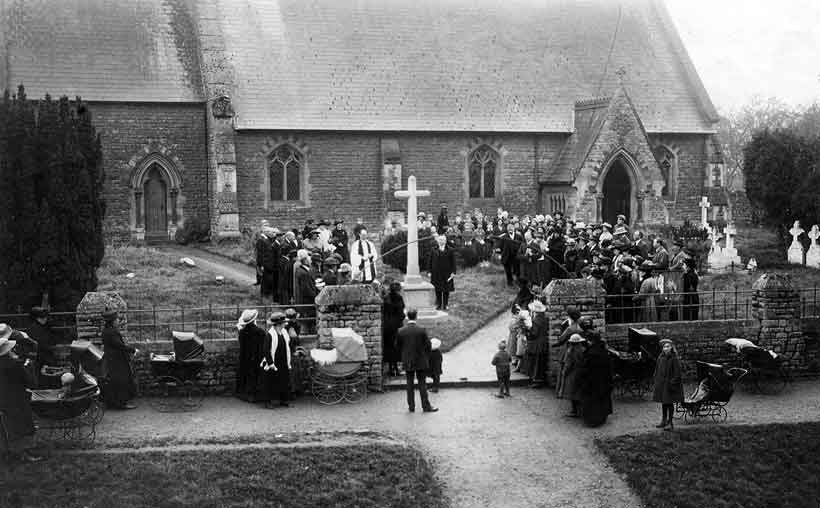
The first service at the memorial December 16th 1921
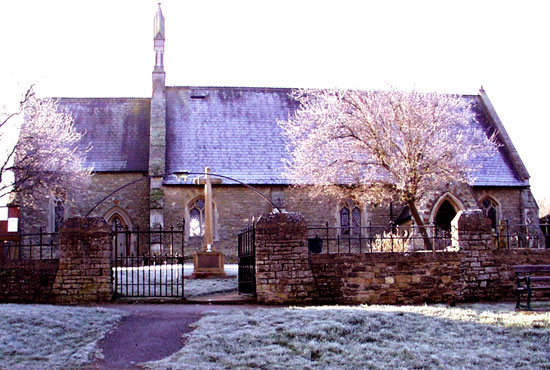
St Leonard’s 1999 Brenda Pittam
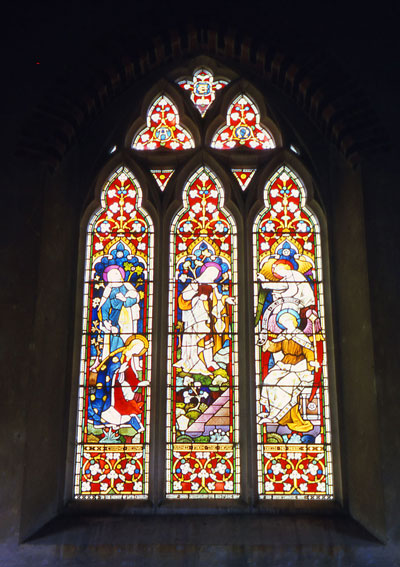
1960s windows and 1999 church. B Pittam.
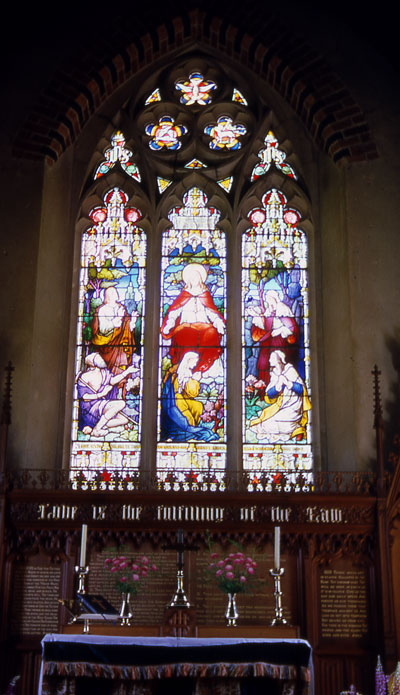
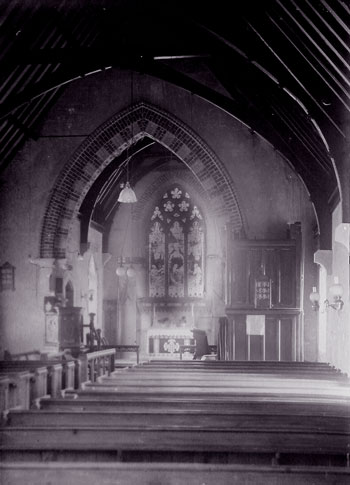
St Leonards the organ in original position.
1940s photograph by Mr De Blois Leach – Northants Record Office.
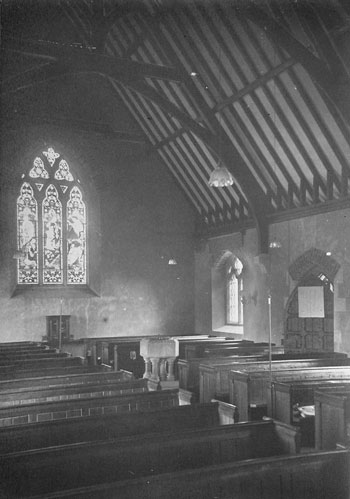
St Leonards where the organ now stands.
1940s photograph by Mr De Blois Leach – Northants Record Office.